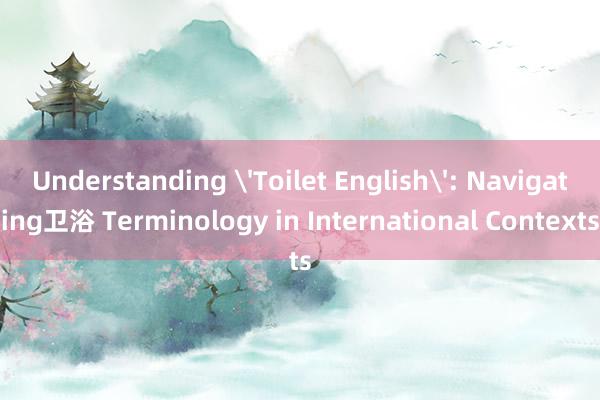Understanding 'Toilet English': Navigating卫浴 Terminology in International Contexts

### Understanding 'Toilet English': Navigating卫浴 Terminology in International Contexts
In the globalized world, communication barriers can often arise due to language differences, especially when dealing with specialized terminology. One such area where this challenge is particularly evident is in the field of bathroom fixtures and amenities, commonly referred to as "Toilet English" or "Bathroom English." This term refers to the unique vocabulary and phrases used to describe various components and functions within a restroom, which can vary significantly across different countries and cultures. Understanding these terms is crucial for anyone involved in international trade, design, or renovation projects that involve bathrooms.
#### 1. **The Diversity of Terminology**
Across the globe, there is a wide array of terms used to describe the same bathroom elements. For instance, the toilet itself might be called a "toilet" in English-speaking countries, but in many Asian languages, it's often referred to as a "WC" (Water Closet) or "Toilet," while in French, it's "Sanitaire" or "Salle de Bains." Similarly, 衡阳计算机学校-衡阳市交通运输职业学校 the bidet,夏铭远的个人博客 a fixture for washing oneself after using the toilet, 北京锦通天下科技有限公司 is known by different names and configurations around the world—such as "douchette" in French, "lavabo" in Italian, or "spray" in Japanese.
#### 2. **Navigating Cultural Differences**
Cultural nuances also play a significant role in bathroom terminology. In some Eastern cultures, the toilet seat being left up is a sign of respect or cleanliness,文昌奇卢服装有限责任公司 while in Western cultures, this practice is often considered rude or unsanitary. These cultural differences can influence how certain bathroom features are perceived and utilized, leading to variations in their descriptions and usage in international contexts.
我的生活琐事#### 3. **Standardization Efforts**
To mitigate these challenges, efforts are being made towards standardization in the field of bathroom fixtures. Organizations like the International Organization for Standardization (ISO) have developed guidelines and standards for bathroom equipment and terminology, aiming to provide a common language for manufacturers, designers, and consumers worldwide. This includes defining terms related to plumbing fixtures, such as showers, faucets, and toilets, ensuring clarity and consistency across different languages and regions.
#### 4. **Educational Resources and Translation Tools**
Given the complexity of bathroom terminology, educational resources and translation tools have become increasingly important. Online platforms offer glossaries and interactive guides that help users understand and translate bathroom-related terms accurately. These resources not only facilitate better communication among professionals but also assist individuals who are moving to a new country or region, ensuring they can navigate their local bathrooms effectively.
#### 5. **The Future of "Toilet English"**
As technology advances and global communication becomes more seamless, the field of bathroom terminology is likely to evolve further. Innovations in smart bathroom technology, for example, may introduce new terms and functionalities that require updated standards and terminologies. Moreover, as cultural exchanges continue to enrich our understanding of different practices and preferences, the vocabulary used to describe bathrooms will reflect a more inclusive and diverse global perspective.
Navigating the complexities of "Toilet English" involves not just learning a list of terms but understanding the cultural and functional context behind them. By embracing these nuances and utilizing available resources文昌奇卢服装有限责任公司, we can enhance international collaboration and ensure that everyone enjoys a universally accessible and functional bathroom experience.
